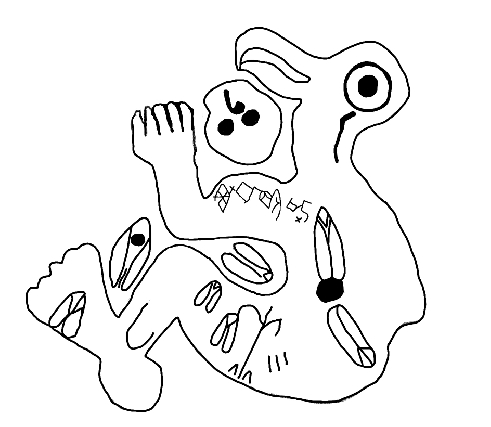
It is known that every birdman, under a heavy taboo, retired for his year's isolation (Métraux 1940: 340). The rock drawing (Lee 1992: 139, fig. 5.7) corresponds to this information: a birdman is decorated with 12 lines. Apparently they denote the 12 months. Another birdman (Lee 1992: 139, fig. 5.6) has a "headdress" which consists of 12 lines (the marks of the months) indeed. It is intriguing that the lines are united in the two groups. The first group contains 5 lines, and the second -- 7 ones. According to A. Métraux (1940: 333), the feast of the birdman began no earlier than January. Assume that the left upper line denotes the month Tuaharo '8th month, January, lit. 'The return journey', i.e. the months after the summer solstice' (see my article "The Rapanui Names of the Places and Statues"). In this case the left part of the lines designates the 5 months from Tuaharo (January) till Vaitu-poto (May). The second group of the lines are the 7 months from Maru/Maro (the 1st month, June; the winter solstice) till Koro (the 7th month, December; the summer solstice). The semicircle on the birdman's head can denote the month Maru (Maro) 'Shadow' (Barthel 1978: 49). Actually, in July the ancient Easter Islanders gathered at the places Mataveri and Orongo and performed the first ceremonies awaiting the coming of the first birds (Métraux 1940: 340). The similar sign represents the partial eclipsed sun in another Rapanui rock picture (Rjabchikov 1998: 231).
Notice that both pictures dedicated to the birdman cult are from the ceremonial centre Mata Ngarau, at Orongo, closely connected with the birdmen's elections. Let us examine two additional figures from the same site.

Figure 1 represents a birdman associated with the vulva sign. In my opinion, it is glyph 1 Tiki, the name of the sun deity Tangaroa (Tane, Makemake). The cupule united with the vulva sign may be read as Rapanui hakatuu 'to mark; sign; mark; to predict; to number; to add' or tataku 'to add; to count' (cf. also taku 'to predict' and tataki 'womb') (1). The wordplay is quite possible: cf. Rapanui komari 'vulva' and Maori komaru 'the sun', Rapanui ra'a 'the sun' and 'day', tiko 'menstruation', Tiki 'the name of the sun god', and katiki 'the solar corona'. So the cupule associated with the vulva petroglyph is a generic determinative '(a new) day'. A Rapanui rock (Lee 1992: 51, fig. 4.10) is covered with the 11 komari and 11 cupules, thus both signs can have the common reading.

Figure 2 represents a birdman connected with different motifs. The 5 vulva petroglyphs (glyphs 64 mea 'red') are incised on the birdman figure and near it. I think it is the name of Tangaroa Mea registered in a Rapanui myth (Métraux 1940: 310-1). Then the sign referred to glyph 25 hua (cf. Rapanui hua 'fruit; to bloom; to sprout', Mangarevan hua 'to produce', Tuamotuan ua 'to be born') is a hint of the month's name Tangaroa-uri where uri corresponds to Maori uri 'progeny, offspring' (see my article "The Rapanui Chant "He Timo te Akoako": Origin and Interpretation"). In the month Tangaroa-uri (October) the locals cleaned up of the fields (Barthel 1978: 52). I read the signs which correppond to glyphs 29 ru(a) and 83 ti as the month's name Ruti (November). The sun becomes too hot in day this month (Barthel 1978: 52), so it is natural to read glyph 34 ra'a 'the sun; day' near it. In the month Koro (December) the increasing heat occures (Barthel 1978: 52), and this is described with the help of the sign 'bivalve' (glyph 120 ngi, consists here of both glyphs 1 Tiki, cf. Rapanui ngingingi 'small bivalve', ngii 'dazzling shine of the sun', ngiingii 'hot', ngihingihi 'dry' as well). The bright sun is also specified by the petroglyphs Vulva (glyph 1 Tiki), Face (glyph 60 mata 'face; eyes'), and two Rhombs (glyphs 67 pi, cf. Maori pi 'eye'). The Face and Rhombs are placed alongside each other. The analogous combination Roro Piapia 'The Head/Skull -- the Big Eyes' is found in the kai-kai chant "Mata nui, Mata iti" (Blixen 1979: 69):
Mata nui a raka e. The Big and Wide Eyes (= the summer). Mata iti. The Small Eyes (= the winter). A Roro Piapia. The Head -- the Big Eyes (the summer).
The petroglyphs referred to glyph 41 Ree and the glyph combination 14 41 (2) Hau Ree ((Ariki) Mau) denote the star Antares, a herald of the summer solstice (see my articles "Linguistic Evidence of Early Peruvian-Rapanui Contacts", "The Rapanui Names of the Places and Statues", "The Rapanui Chant "He Timo te Akoako": Origin and Interpretation", and "Rongorongo: The Milky Way and Antares").
1. The term taki related to taku, tataki is presented in the place name Ko te Hare te Reinga Taki (Lee 1992: 156), the last dwelling of the legendary king Hotu Matu'a. Interestingly, Rapanui hare means 'house', Maori rei -- 'canoe', matua 'father; placenta; hull of canoe', Rapanui matua -- 'father', Tahitian hotu -- 'to produce fruit'. So Reinga Taki is a variant of the name Hotu Matu'a.
2. Glyph 14 is inverted here.
Barthel, T.S., 1978. The Eighth Land The Polynesian Discovery and Settlement of Easter Island. Honolulu: University of Hawaii Press.
Blixen, O., 1979. Figuras de hilo tradicionales de las Isla de Pascua. Moana: Estudios de Antropología Oceánia, 2(1): 1-106.
Lee, G., 1992. The Rock Art of Easter Island. Symbols of Power, Prayers to the Gods. Los Angeles: The Institute of Archaeology Publications (UCLA).
Métraux, A., 1940. Ethnology of Easter Island. Bishop Museum Bulletin 160. Honolulu: Bernice P. Bishop Museum.
Rjabchikov, S.V., 1998. Polynesian Petroglyphs: Reports about Solar Eclipses. Journal de la Société des Océanistes, 107(2): 231-2.
Copyright © 1999 by Sergei V. Rjabchikov. All Rights Reserved.